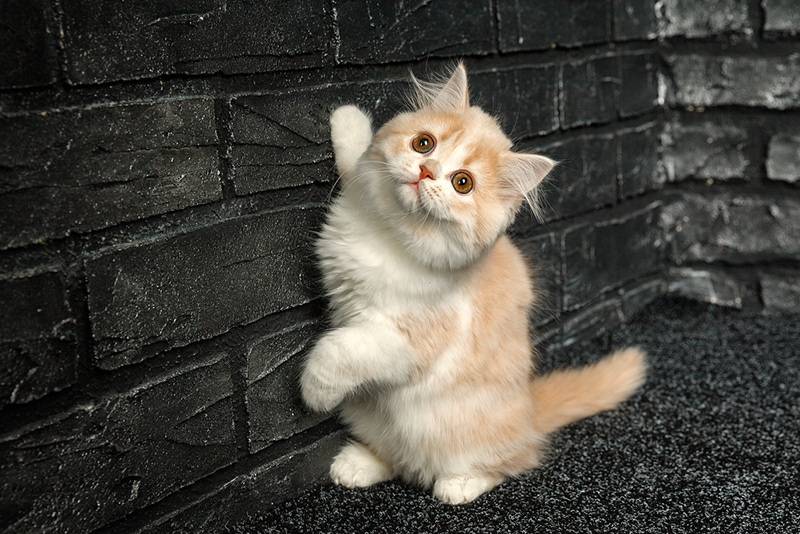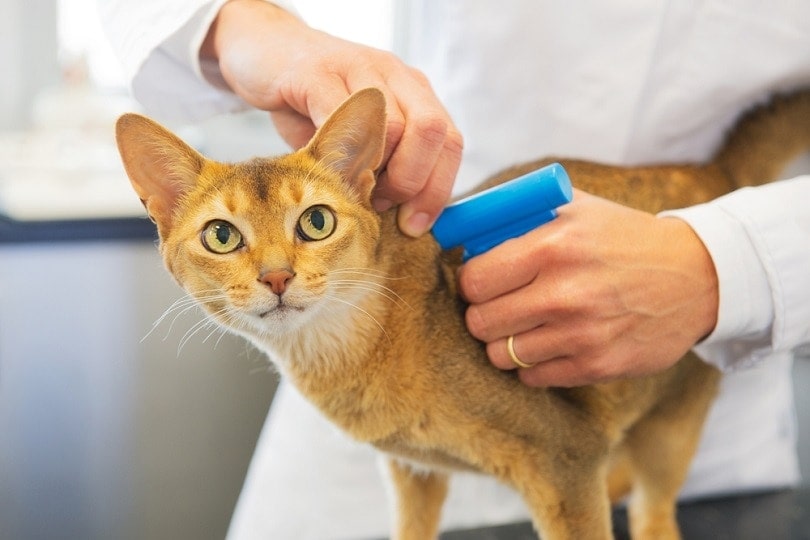20 Incredible Australian Cat Statistics & Facts: Updated in 2024
Updated on

Click to Skip Ahead
Note: This article’s statistics come from third-party sources and do not represent the opinions of this website.
There is no doubt that Australians are a nation of animal lovers. Cats rank highly as a favorite pet, second only to dogs.
Cats are not native to Australia, and it is hypothesized that a first few arrived in the country with the early European settlers, possibly in the late 18th century. They were later deliberately introduced and encouraged to multiply as a means of controlling the exploding rabbit and rodent population.
Today, cats in Australia fall into one of two categories. They are either much-loved pets or a problem invader that poses a serious threat to the local wildlife.
Let’s have a look at some statistics that will describe the role of cats in both of these groups. They are organized into the following categories:
Top 20 Australian Cat Statistics
- There are 5.33 million pet cats in Australia in 2022.
- 33.3% of households own at least one cat.
- The average number of cats per household is 1.6.
- 67% of cat owners only have one cat, 23% have two cats, and 10% have three or more cats.
- There has been a 6% increase since 2019 in the number of households that have a pet cat.
- A 2019 report found that 71% of all pet cats were mixed breeds, 24% being purebred.
- The number one reason for Australians to get a pet cat is companionship, according to 44% of respondents.
- 74% of pet cats are microchipped.
- 28% of cats were acquired through cat shelters.
- Cats acquired through friends, family, or neighbours account for 25% of all cats.
- 14% of cats were bought from a breeder.
- A total of 10% of pet cats are adopted strays.
- The average cost of a cat has risen from $289 at the end of December 2020 to $804 in 2022.
- The average spend per cat, per household, per year is $1,715.
- Australian cat owners who visited the vet in the last 12 months spent an average of $936 on vet visits for their cats, per household.
- The average cat insurance premium is $795.
- There are around 2.07 million feral cats in Australia.
- It is thought that there are about 710,000 stray or partially owned cats nationwide.
- Cats are estimated to kill 2,167 million small animals every year.
- Cats played a major role in the extinction of 25 native mammal species.

 Interesting Facts About Cat Ownership
Interesting Facts About Cat Ownership
1. There are 5.33 million pet cats in Australia in 2022.
(Animal Medicines Australia)

Cats are almost as popular as dogs in Australia when it comes to choosing four-legged friends with whom to share the home. The total number of pet cats in 2022 is 5,333,2000, compared with 6,375,600 pet dogs.
2. 33.3% of households own at least one cat.
(Animal Medicines Australia)
Around one-third of Australian households own at least one cat, compared to nearly half of all households that own a dog. Contrasting this percentage with the total number of pet cats tells us that households that do own a cat are more likely to own more than one, and are additionally likely to own more cats than dogs.
3. The average number of cats per household is 1.6.
(Animal Medicines Australia)

The number of cats across all cat-owning households in Australia averages 1.6 cats per home. This is expanded on in fact number four.
4. 67% of cat owners only have one cat, 23% have two cats and 10% have three or more cats.
(Animal Medicines Australia)
The majority of cat-owning households only have one cat, with around a quarter owning two cats. Just 10% of households have three or more feline companions.
5. There has been a 6% increase since 2019 in the number of households that have a pet cat.
(Animal Medicines Australia)

Between 2019 and 2022, cats increased in popularity. In 2019, 27% of all households owned at least one cat, compared to 33% of households in 2022. This could be attributed to the need for companionship and emotional support during the challenging times associated with the Pandemic.
6. A 2019 report found that 71% of all pet cats were mixed breeds, 24% being purebred.
(Animal Medicines Australia)
The 2019 Pet Ownership Study, conducted by Animal Medicines Australia, reported that 71% of pet cats were mixed breeds—with 24% being purebred and/or designer breeds—the most popular purebreds being Siamese, British Shorthair, Bengal, Ragdoll, Maine Coon, Burmese, Russian Blue, and Persian cats.
7. The number one reason for Australians to get a pet cat is companionship, according to 44% of respondents.
(Animal Medicines Australia)

The majority of Australian cat owners report that their main reason for having a cat is companionship. Roughly 32% of owners say their reason was because the cat was a rescue, while 21% and 20% stated mental health benefits and relaxation, respectively. Other common reasons given for having a pet cat as a service animal, they were gifted the cat, or it is a companion for another pet.
8. 74% of per cats are microchipped.
(Animal Medicines Australia)
Although it is compulsory in all but one of the Australian states for cats to be microchipped, only 74% of cats are. This represents a decrease from 77% of cats that were microchipped in 2019.
 Acquisition of Pet Cats
Acquisition of Pet Cats
9. 28% of cats were acquired through cat shelters.
(Animal Medicines Australia)

A very heartening 28% of pet cats were obtained from shelters.
10. Cats acquired through friends, family or neighbors accounted for 25%.
(Animal Medicines Australia)
Not far behind shelter cats are those that were acquired by word-of-mouth from friends, family, or neighbors.
11. 14% of cats were bought from a breeder.
(Animal Medicines Australia)

Only 14% of cats were acquired from a breeder, with 11% coming from pet shops and 5% coming from vets. The number of cats bought from a pet shop represents a 3% increase from 8% in 2019.
12. A total of 10% of pet cats were adopted strays.
(Animal Medicines Australia)
The overwhelming majority of pet cats were animals in need of a home, rather than those bred specifically as pets. This majority comprises cats from shelters, cats obtained from acquaintances, and the 10% of adopted strays.
 Cost of Owning a Pet Cat
Cost of Owning a Pet Cat
13. The average cost of a cat has risen from $289 at the end of December 2020 to $804 in 2023.
(Animal Medicines Australia)

The average cost to buy a pet cat has increased staggeringly since 2019. The cost of $804 represents an almost three-fold increase, and it is suggested that this is Pandemic-related. There is no specific explanation for the increase, however.
This figure does include cats that were obtained for free, which accounts for 38% of all pet cats in 2022. Although this figure is down from the pre-March 2020 figure of 44%, it is a slight increase from the end of 2020 amount of 37% , and indicates a likely continued increase in the future.
14. The average spend per cat per household per year is $1,715.
(Animal Medicines Australia)
Each cat in the household costs an average of $1,715 to keep per year. The bulk of this figure consists of money spent on cat food, with the next most expensive component being veterinary services.
15. Australian cat owners who visited the vet in the last 12 months spent an average of $936 on vet visits for their cats, per household.
(Animal Medicines Australia)

For owners who took their cats to the vet in 2022, the average cost of those veterinary visits was $936 per cat. Only 41% of cat owners accrued any veterinary service-related costs.
The high cost of veterinary care may explain why many pet owners opt to take out pet insurance for their cats.
(Animal Medicines Australia)
Due to the high costs of veterinary care in Australia, many pet owners opt to take out pet insurance to ensure that they are covered for the unexpected. Cat owners reported that their cat insurance premiums cost them an average of $725 per year.
Despite the security provided by pet insurance, the number of owners who insure their cats has dropped considerably in the last few years—from 21% to 12%. Many owners state that insurance is too expensive and they can’t see the value in it.
 Impact of Cats on Native Wildlife
Impact of Cats on Native Wildlife
17. There are around 2.07 feral cats in Australia.
(Australian Veterinary Association)

It is estimated that there are approximately 2.07 million feral cats in Australia—although this number is known to fluctuate greatly according to seasonal factors. At any one time, there may be between 1.4–4.6 million feral cats in Australia. There are likely to be more feral cats in higher rainfall areas.
18. It is thought that there are about 710,000 stray or partially owned cats nationwide.
(Australian Veterinary Association)
There are over 700,000 stray cats, some of which may be partially cared for by people, nationwide. These cats are primarily found in urban areas.
19. Cats are estimated to kill 2,167 million small animals every year.
(Invasive Species Council)

Pet cats, stray cats, and feral cats combined are believed to be responsible for killing about 2,167 million small animals per year. These include mammals, reptiles, birds, and frogs. Feral cats, in particular, are responsible for killing the majority of native animal species that comprise this number.
20. Cats played a major role in the extinction of 25 native mammal species.
(Invasive Species Council)
It is estimated that about 33 native mammal species have become extinct since colonization by early European settlers. Cats played a significant role in the extinction of 25 of these 33 species.
 Frequently Asked Questions About Australian Cats
Frequently Asked Questions About Australian Cats
How Many Cats are Australians Allowed to Have?
Whilst there are no national laws regarding the number of cats a household may own, certain councils in particular states have passed bylaws that restrict the number of cats to two or three in most cases. In some regions, the number of cats you can own is dependent on the size of your property.
More recently, in an attempt to tackle the serious threat that cats pose to native wildlife, rather than restrict the number of cats allowed, some councils have introduced cat curfews. Depending on the area, cats are either allowed out only between certain hours, or not at all, unless on a leash. The latter sees cats being treated similarly to dogs.
Residents of areas whose councils have imposed cat curfews can face hefty fines of up to $1,600 if found to be in violation of the bylaws.

Do Pet Cats Have to Be Sterilized?
The management of animals is a state or territory-legislated responsibility, rather than one which is governed nationally. Therefore, the ruling as to whether cats need to be sterilized differs, depending on where in Australia you are.
In Western Australia, Tasmania, Australian Capital Territory, and South Australia, cats are required by law to be sterilized by the time they are 3–6 months old, depending on the region. This represents half of Australian states and territories.
Additionally, some states may have local council bylaws that differ from the state’s ruling.
Is Anything Being Done About the Destruction of Australian Wildlife by Cats?
The aforementioned measures of imposing curfews and mandating desexing are all aimed at minimizing the decimation of the small animal population by cats. Cats are indiscriminate and highly effective predators, and their negative impact on—particularly—the native small animal population is significant.
The Australian Government does not take the situation lightly and mass culling programmess have been spoken of and planned since 2018. It is unclear whether these programmes have been implemented, as they were met with much resistance by various animal welfare groups. Many of the culling methods are widely considered to be inhumane.
Other more humane methods of protecting native wildlife from cats are constantly being discussed, trialed, and implemented. To date, however, there has not been an effective solution realized.
Conclusion
The role of cats in Australian society is contradictory. It would seem that they are either adored as beloved pets, or loathed as destructive vermin. For many conflicted souls they might be a bit of both. As with most things in life, it all comes down to perspective. Either way, cats offer a significant contribution to the Australian way of life.
Featured Image Credit: Kolomenskaya Kseniya, Shutterstock

 Interesting Facts About Cat Ownership
Interesting Facts About Cat Ownership








